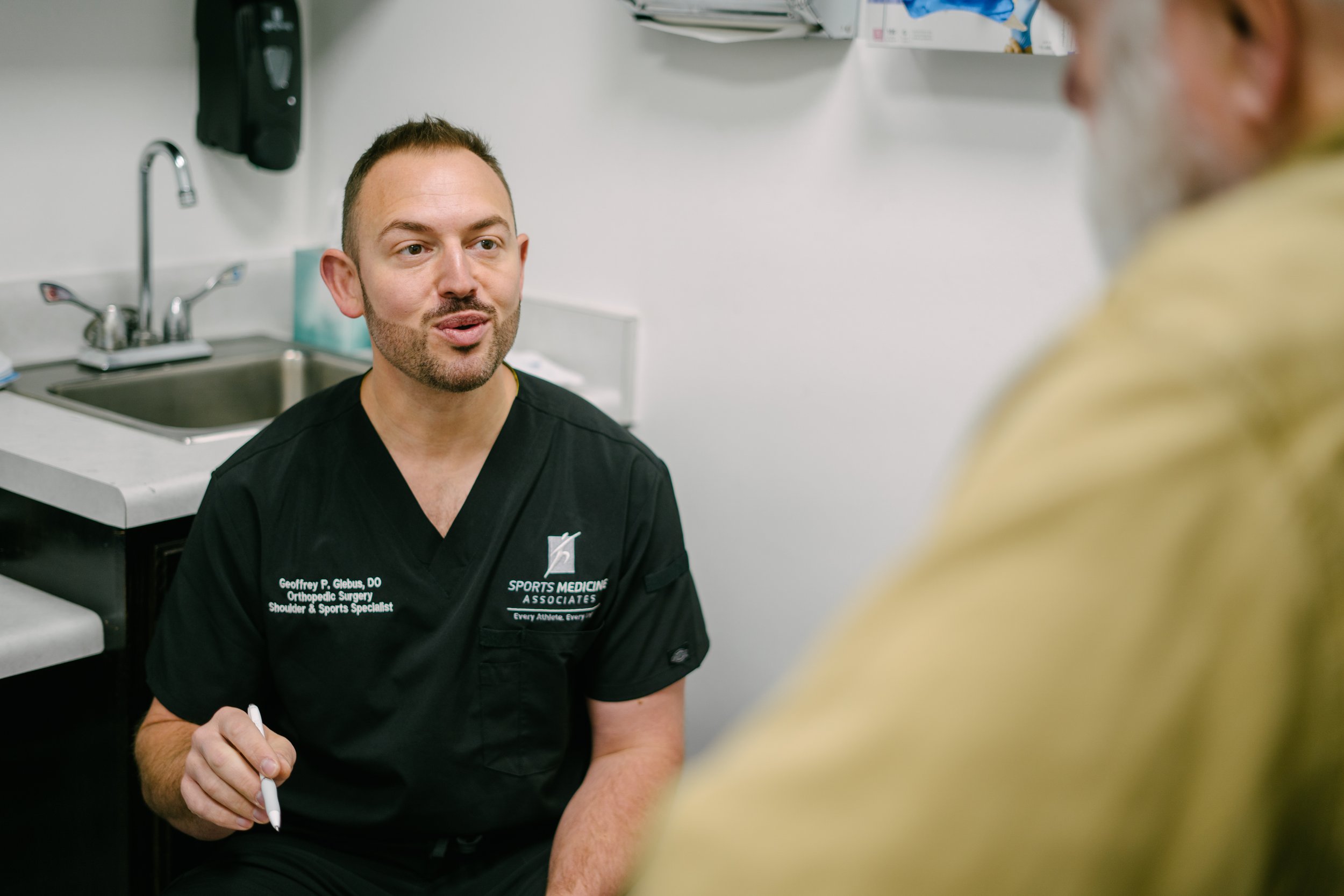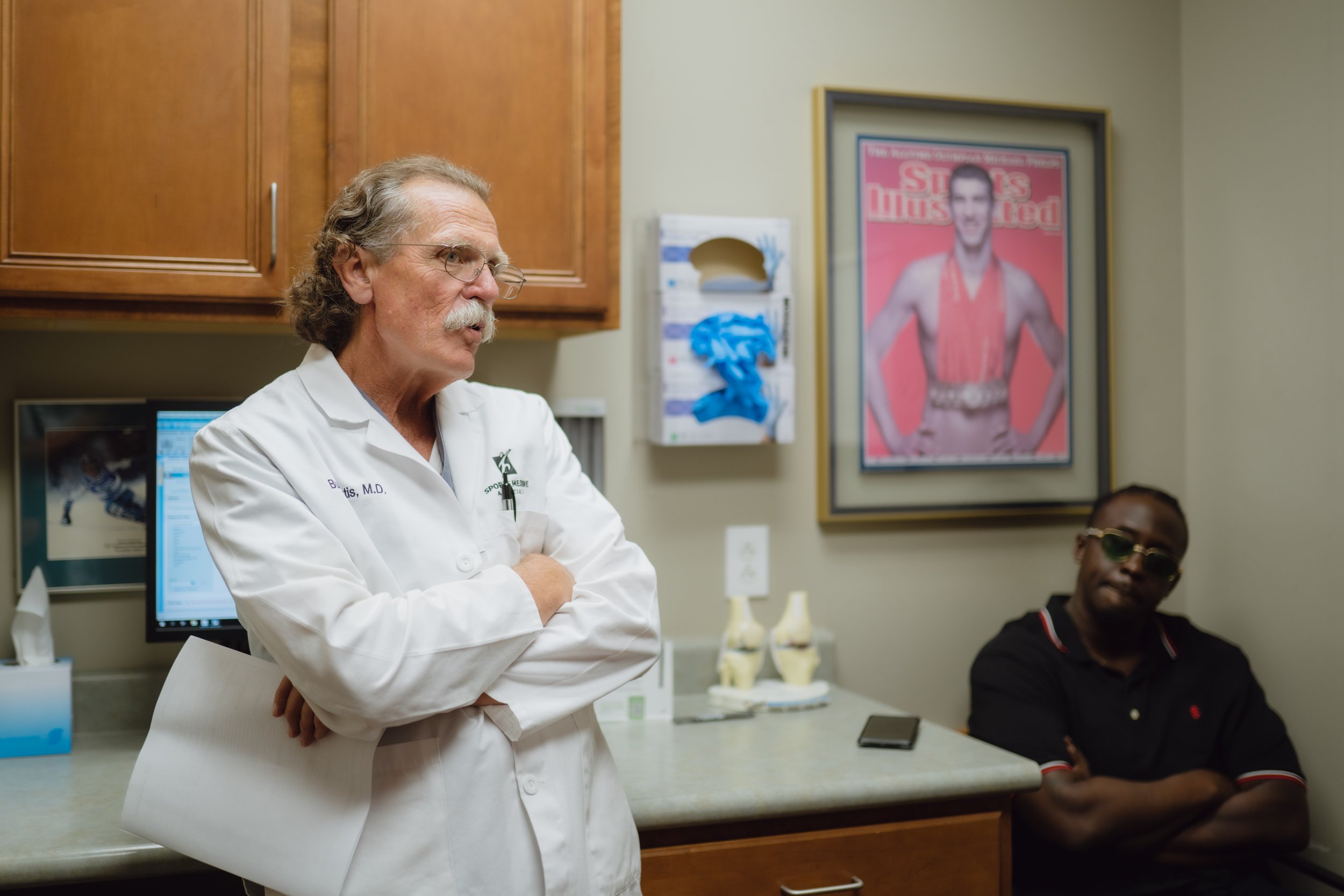Hip Replacement (Arthroplasty) Specialists In San Antonio
Hip replacement surgery — also referred to as arthroplasty — is a surgical option for people dealing with hip pain.
During a hip replacement surgery, the ball is removed, the socket is cleaned out, and replaced with man-made artificial parts.
In some cases, the bones themselves are damaged and need to be shaved or replaced as well — this is usually from traumatic accidents and not typical joint wear and tear. The forces are a little bit different through the hip so a little bit more is removed in comparison to knee replacement surgery.
Joints are considered any spot in your body where two or more bones meet and are attached by muscles, tendons, and ligaments to create movement. Cartilage is a type of padding between the joints to prevent the bones from rubbing together.
Over time the cartilage wears down. Playing sports and having injuries to these areas can cause this to happen at a more rapid pace. This is a major cause of joint replacement surgeries along with arthritis.
If your pain doesn’t go away with medication, physical therapy, and daily activity changes then your doctor will likely offer arthroplasty as a solution.
Dr. Glebus of Sports Medicine Associates of San Antonio discusses the different surgical options for hip replacements.
WHY CHOOSE SPORTS MEDICINE ASSOCIATES OF SAN ANTONIO FOR YOUR JOINT REPLACEMENT SURGERY?
As one of San Antonio’s most prestigious orthopedic clinics, you can count on our doctors at Sports Medicine Associates of San Antonio (SMASA) to take care of any joint issues you’re experiencing.
We don’t only serve the community, we also serve the most elite professional athletic teams in San Antonio. They trust our doctors over all the others to take care of every need.
If you’re considering having a joint replacement surgery done, schedule an appointment with any of the following doctors to make sure you get the best care you possibly can.





FAQs
WHAT DOES A HIP REPLACEMENT PROCEDURE ENTAIL?
Before the surgery begins, doctors may use anesthesia or nerve blockers to prevent you from experiencing pain during and shortly after the procedure.
Depending on the type of damage your joint has, there are different things that will need to be done during surgery.
If you have severe damage to your cartilage, it will likely be removed and replaced. Cartilage is an important part of the joint since it absorbs any shock or impacts your joints take.
Your surgeon may need to shave down your bone to allow for the replacement parts to fit properly onto your bone.
WHAT ARE PROSTHETICS MADE OUT OF?
Prosthetics can be made out of several different materials including:
Titanium
Stainless steel
Ceramic
Plastic
The prosthetic parts will replace the non-functional parts of your hip to make it completely functional and pain-free.
You can expect to have pain in your hip after the surgery for a few weeks since your body needs time to heal and adjust to its new parts. Properly preparing for your surgery can help to shorten the recovery period and reduce the length of time you experience pain.
HOW DO YOU PREPARE FOR HIP REPLACEMENT SURGERY?
Learning about the surgery you’ll be having done can help you to feel more comfortable with the procedure. Asking your doctor questions about their particular protocols can help to ease any anxiety you may have.
Muscles atrophy after surgery is performed. So if you don’t strengthen them before you have surgery your recovery can turn into an uphill battle. By doing strengthening and stability exercises before your surgery you can make your recovery a little bit easier for yourself.
Even with strengthening ahead of time, your muscles will still be weakened after surgery, but getting ahead is always best.
Eating healthy can help to reduce unnecessary inflammation throughout your body and this can help your recovery too.
Some things you might want to stock up on for your recovery include:
Ice packs
Pain/anti-inflammatory medication
Proper bandages and wound care items
Walker, cane, or crutches (these will typically be provided by the hospital but double-check with your doctor just in case)
Comfortable pillows
Assistive items like shower benches and handrails
Ask family or friends ahead of time for help so you don’t feel alone during your recovery. You won’t be able to drive by yourself so setting up transportation services will be helpful.
WHAT DOES THE RECOVERY LOOK LIKE?
While the typical image in our brain of post-surgery recovery is someone in a bed for weeks on end watching tv, this won’t be the case.
It’s actually quite different than you’d expect. Your orthopedic surgeon will have you start moving that day and usually, you’ll start physical therapy the day of surgery or the day after.
The sooner you start your exercise the sooner you’ll be functionally using your hip to get back to your daily tasks and the things you love to do. However, you shouldn’t overdo it either.
Following the guidelines set up for you by your orthopedic surgeon and their team will help you to recover at the proper pace.
Doing exercises and using ice to maintain inflammation will have you back to your pre-pain self quicker than you can imagine. It can take anywhere from 6 months to a year for a full recovery. Your new hip should last you anywhere from 15-20 years. Your doctor will check in with you periodically to make sure everything is going according to the plan they set in place for you.
WHAT ARE SOME POTENTIAL COMPLICATIONS WITH SURGERY?
Nothing is without risk, but arthroplasty has come a long way from when it first began. So much so, that it’s becoming an outpatient procedure for the right patients.
Some complications that your doctor will talk with you about include:
Blood clots
Infections
Complications with the prosthesis (dislocation, loosening, etc.)
Nerve injuries
Allergies to anesthesia
Many of these complications can be avoided with proper practices from your surgeon and a strict care plan.

